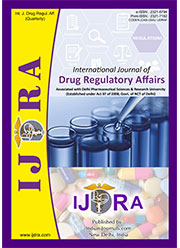Regulations on Herbal Products in India, United States and European Union: A Review
Abstract
Herbal products are now being mainstay of about 80% of the world population for primary health care. The belief that herbs are safe is not completely true, as many cases of untoward effects are observed following their imprudent use. Therefore, we need to have regulative measures on herbal products that would keep check on each step of entire process of drug development. Ensuring efficacy and safety of these products is going to increase the global acceptance and would be serving a greater number of populations worldwide in an inculpable manner. Working in this direction almost every country has developed their plan of work for regulation of herbal products that are referred as traditional medicines, alternative medicines, complimentary medicines, natural health product, health supplements etc. Electronic review method was used to compile information for this review on the regulation of herbal product around the world in this study. The data were collected from different databases such as Google scholar, ResearchGate, PubMed, pharma tutor, and etc.
Downloads
References
2. Brower V. Nutraceuticals: Poised for a healthy slice of the healthcare Market. Nabbt Biotechnol. 1998;16:728–31.
3. Baby C, Gopal K, Nazia K, Shahid H, Ansari. Current concepts and prospects of herbal nutraceutical: A review. J Adv Pharm Technol Res. 2013 Jan-Mar;4(1):4–8.
4. Sanjay S. Current status of herbal product: Regulatory overview. Journal of Pharmacy & Bioallied Sciences. 2015 Oct-Dec;7(4):293–296.
5. Anupama S, Vikas AS, Vandana K, Anil B. Current status of regulations for herbal medicine in Europe, USA and India. Journal of Natura Conscientia. 2011; 2(3):406-422.
6. Nitin V. Herbal Medicines: Regulation and Practice in Europe, United States and India. International Journal of Herbal Medicine. 2013;1(4):1-5.
7. Faruque A, Fakhruddin AA, Azaz AA, Sarfaraz A, Amir A. Nutraceutical is the need of hour. World journal of pharmacy and pharmaceutical sciences. 2013 Aug; 2(5):2516-2525.
8. Ganesh G, Ramachandran A, Suresh KR, Senthil V, Baviya PR. Nutraceuticals - A regulatory review. International Journal of Drug Regulatory Affairs. 2015; 3(2):22-29.
9. Om PG, Peter BO. Legislation relating to nutraceuticals in the European Union With a particular focus on botanical-sourced products. Toxicology. 2006;221:75–87.
10. Manish R, Lovedeep N, Aayushi G, Harvinder P. Cosmetics: Regulatory and market scenario for us and India. The Pharma Innovation Journal. 2018;7(6):164-169.
11. Helena E, Louis W, Musa S. The Regulation of Personalized Cosmetics in the EU; Cosmetics. 2019; 6(1):29.
12. Omprakash G, Madhuri C, Vijayendra S, Sachin B, Giram P, Mahesh JB. Phytopharmaceuticals: An emerging platform for innovation and development of new drugs from botanicals. Journal of Drug Delivery & Therapeutics 2019; 9(3-s):1046-1057.
13. Abhishek S, Muthusamy K, Priyanka C, Sushma S, Ramesh KG, Suresh KG. Opportunities and Challenges in Development of Phytopharmaceutical Drug in India- A SWOT Analysis. J Young Pharm 2019;11(3):322-327.

This work is licensed under a Creative Commons Attribution-NonCommercial 4.0 International License.
The International Journal of Drug Regulatory affairs require a formal written transfer of copyright from the author(s) for each article published. We therefore ask you to complete and return this form, retaining a copy for your records. Your cooperation is essential and appreciated. Any delay will result in a delay in publication.
I/we have read and agree with the terms and conditions stated Page 2 of this agreement and I/we hereby confirm the transfer of all copyrights in and relating to the above-named manuscript, in all forms and media, now or hereafter known, to the International Journal of Drug Regulatory affairs, effective from the date stated below. I/we acknowledge that the IJDRA is relying on this agreement in publishing the above-named manuscript. However, this agreement will be null and void if the manuscript is not published in the IJDRA.
Download link for COPYRIGHT FORM







